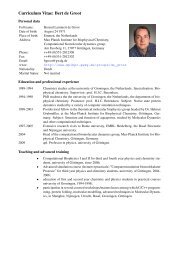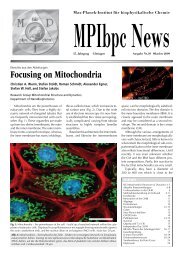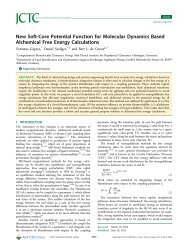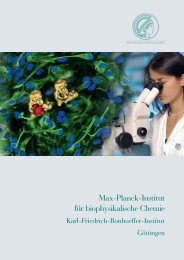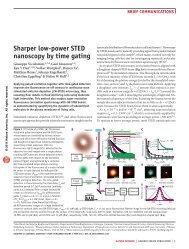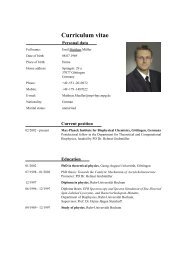Elastic Properties of Photoswitchable Azobenzene Polymers from ...
Elastic Properties of Photoswitchable Azobenzene Polymers from ...
Elastic Properties of Photoswitchable Azobenzene Polymers from ...
You also want an ePaper? Increase the reach of your titles
YUMPU automatically turns print PDFs into web optimized ePapers that Google loves.
Nanotechnology<br />
DOI: 10.1002/ange.200604595<br />
<strong>Elastic</strong> <strong>Properties</strong> <strong>of</strong> <strong>Photoswitchable</strong> <strong>Azobenzene</strong> <strong>Polymers</strong> <strong>from</strong><br />
Molecular Dynamics Simulations**<br />
Lars V. Schäfer, E. Matthias Müller, Hermann E. Gaub, and Helmut Grubmüller*<br />
Nanomechanical devices or molecular machines will, for a<br />
broad range <strong>of</strong> applications, most likely be powered by light<br />
or other kinds <strong>of</strong> electromagnetic radiation. [1–4] The major<br />
reasons are ease <strong>of</strong> addressability, picosecond reaction times<br />
to external stimuli, and compatibility with a broad range <strong>of</strong><br />
ambient substances, such as solvents, electrolytes, or gases.<br />
<strong>Azobenzene</strong> is a well-studied photoactive system, which can<br />
be photoswitched selectively <strong>from</strong> an extended trans to a<br />
more compact cis conformation by using light <strong>of</strong> wavelength<br />
365 nm, whereas the reverse cis-to-trans isomerization is<br />
induced by light <strong>of</strong> wavelength 420 nm (Figure 1a). [5, 6] Many<br />
processes, such as light-driven ion transport through biological<br />
membranes, [7–9] can be steered by conformational switching<br />
<strong>of</strong> azobenzene chromophores. <strong>Azobenzene</strong> has been used<br />
frequently in synthetic photoresponsive systems for the<br />
regulation <strong>of</strong> the geometry and function <strong>of</strong> biomolecules. [10–19]<br />
The isomerization <strong>of</strong> individual azobenzene molecules has<br />
[20, 21]<br />
also been studied by scanning tunneling microscopy.<br />
Recently, a bistable polyazobenzene peptide was synthesized<br />
as a model system for a light-powered molecular<br />
machine, and its mechanical properties were characterized<br />
by means <strong>of</strong> single-molecule atomic force microscopy (AFM)<br />
experiments (Figure 1b, c). [22, 23] Optical switching <strong>of</strong> the<br />
azobenzene polymers between their extended trans and<br />
compact cis conformations was demonstrated, and the<br />
corresponding change in the contour length <strong>of</strong> the polymer<br />
was detected. Thereby, in analogy to an Otto cycle, Gaub and<br />
co-workers established an optomechanical operating cycle, in<br />
which “optical” contraction against an external force delivered<br />
net mechanical work. [22,23] Thus, they demonstrated that<br />
azobenzene polymers indeed hold great promise for future<br />
[*] L. V. Schäfer, E. M. Müller, H. Grubmüller<br />
Abteilung für theoretische und computergestützte Biophysik<br />
Max-Planck-Institut für Biophysikalische Chemie<br />
Am Fassberg 11, 37077 Göttingen (Germany)<br />
Fax: (+ 49)551-201-2302<br />
E-mail: hgrubmu@gwdg.de<br />
H. E. Gaub<br />
Lehrstuhl für Angewandte Physik und Center <strong>of</strong> Nanoscience<br />
Ludwig-Maximilians-Universität<br />
Amalienstrasse 54, 80799 München (Germany)<br />
[**] We thank I. Tremmel for carefully reading the manuscript and for<br />
valuable comments, and F. Gräter, O. Lange, R. Netz, D. Oesterhelt,<br />
and C. Renner for helpful discussions. L.V.S. thanks the Boehringer<br />
Ingelheim Fonds for a PhD fellowship. Support <strong>from</strong> the EU<br />
Nanomot project (grant 29084) is gratefully acknowledged. H.E.G.<br />
was supported by the Deutsche Forschungsgemeinschaft and the<br />
Fonds der Chemischen Industrie.<br />
Supporting information for this article is available on the WWW<br />
under http://www.angewandte.org or <strong>from</strong> the author.<br />
Angew. Chem. 2007, 119, 1 – 7 2007 Wiley-VCH Verlag GmbH & Co. KGaA, Weinheim<br />
Angewandte<br />
Chemie<br />
applications in nanotechnology, for example, as light-triggered<br />
molecular switches or cargo lifters. In a related<br />
experiment, Vancso and co-workers characterized a redox–<br />
mechanical cycle by using electrochemical AFM-based<br />
single-molecule force spectroscopy. [24]<br />
Figure 1. a) Photochromic azobenzene can be switched between a<br />
compact cis and an extended trans conformation. b) A polyazobenzene<br />
peptide composed <strong>of</strong> Lys-Azo-Gly azotripeptide units. c) Sketch <strong>of</strong> the<br />
AFM experiment which motivated the study described herein. [22, 23] The<br />
azobenzene polymer was attached to the AFM tip through a cysteine<br />
linker (top) and mounted to an amino-functionalized surface<br />
(bottom); adapted with permission <strong>from</strong> the authors <strong>of</strong> ref. [22].<br />
TIR = total internal reflection. d) Space-filling representation <strong>of</strong> the alltrans<br />
conformation <strong>of</strong> the model polymer used for the force-probe MD<br />
simulations. To mimic the AFM experiments, a harmonic spring was<br />
attached to the N terminus (top) and pulled upwards with a constant<br />
velocity, while the C terminus was kept fixed (bottom).<br />
However, the measured overall length change upon<br />
switching between the cis and trans polymers—and thus the<br />
work output—was considerably smaller than could be<br />
expected on the basis <strong>of</strong> the length change <strong>of</strong> a single<br />
1<br />
Ü<br />
Ü<br />
These are not the final page numbers!
Zuschriften<br />
azobenzene monomer and the number <strong>of</strong> individual monomers.<br />
To resolve this discrepancy, and, more generally, to<br />
obtain a detailed understanding <strong>of</strong> the underlying polymer<br />
mechanics at the atomistic scale, we carried out explicitsolvent<br />
force-probe molecular dynamics (MD) simulations<br />
[25,26] <strong>of</strong> polyazobenzene model peptides under mechanical<br />
stress, the results <strong>of</strong> which resemble those <strong>of</strong> the AFM<br />
experiments described in Figure 1c. The simulations provided<br />
detailed mechanistic insight that is prerequisite for the<br />
efficient and targeted optimization <strong>of</strong> photoswitchable polymers<br />
for future applications in nanotechnology. Because we<br />
were only interested in the elastic properties <strong>of</strong> these model<br />
polymers, and not in the photoisomerization kinetics, we kept<br />
the azobenzenes fixed in the cis or trans conformation during<br />
the simulations. We did not include the photoisomerization<br />
itself into our simulations on the assumption that this process<br />
occurs on a much faster time scale than the subsequent<br />
structural rearrangement <strong>of</strong> the polymer. Indeed, sub-picosecond<br />
kinetics have been observed for azobenzene photoisomerization,<br />
[27, 28] a complex process that involves several<br />
energy surfaces. [27–33]<br />
By comparing our simulations to the AFM experiments,<br />
we gleaned insight into the overall elastic properties <strong>of</strong><br />
azobenzene polymers and could relate our results directly to<br />
the measured elasticity characteristics. We were able to<br />
elucidate the crucial role <strong>of</strong> the peptides that interlink the<br />
azobenzene units and to predict the elastic behavior beyond<br />
the experimentally accessible force regime. Finally, we used<br />
the detailed mechanistic understanding thus obtained to<br />
design a photoswitchable polyazobenzene peptide with<br />
improved optomechanical properties.<br />
The model azobenzene polymers used in our simulations<br />
were constructed <strong>from</strong> four azotripeptide units (n = 4 in<br />
Figure 1b). These (Lys-Azo-Gly) 4 dodecamers have the same<br />
stoichiometry as the polymers used in the AFM studies. As in<br />
the experiments, DMSO was used as a solvent. To study the<br />
effect <strong>of</strong> the azobenzene conformation (cis or trans) on the<br />
elastic properties, we considered three stereochemically<br />
different polymers, an all-cis, an all-trans, and a mixed cis–<br />
trans–cis–trans system. The mixed polymer was considered<br />
because complete photoisomerization upon optical pumping<br />
was not achieved in the experiments as a result <strong>of</strong> the<br />
overlapping absorption bands <strong>of</strong> the cis and trans states. [22,23]<br />
A study <strong>of</strong> this polymer would also reveal possible cooperative<br />
effects between adjacent monomers.<br />
The force-versus-extension traces obtained <strong>from</strong> the AFM<br />
experiments reflect the elastic properties expected for a<br />
polymer subjected to a mechanical load. Figure 2a shows the<br />
overall force-extension traces <strong>of</strong> the all-cis, all-trans, and<br />
mixed azobenzene model polymers obtained <strong>from</strong> our forceprobe<br />
MD simulations (over 50–70 ns each). These traces<br />
closely resemble the curves <strong>from</strong> the AFM experiments<br />
(Figure 2a, inset). [22,23] At higher forces above 600 pN, deviations<br />
<strong>from</strong> the wormlike-chain (WLC) behavior are seen.<br />
These deviations are discussed below. As expected, the force<br />
trace <strong>of</strong> the mixed cis–trans–cis–trans polymer lies midway<br />
between those <strong>of</strong> the all-cis and the all-trans polymers. This<br />
result already suggests that cooperative effects between<br />
monomers are unlikely. Therefore, such effects cannot<br />
Figure 2. Force-probe MD force-extension curves for (Lys-Azo-Gly) 4,<br />
obtained at a pulling velocity <strong>of</strong> 0.1 nm ns 1 . a) Curves <strong>of</strong> the all-cis<br />
(blue), all-trans (red), and mixed cis–trans–cis–trans polymers (black).<br />
The overall extension is defined as the distance between the C terminus<br />
and the N terminus along the pulling direction. The extension<br />
difference obtained <strong>from</strong> a WLC fit (smooth lines) <strong>of</strong> 1.45 Š per unit<br />
between the cis and trans polymers (at 200 pN) is shown as a green<br />
dashed line. Arrows indicate events discussed in the text. Inset: WLC<br />
curves obtained <strong>from</strong> experiment (black line) [23] and simulation (red<br />
dashed line) for the all-trans polymer, for the contour length <strong>of</strong><br />
L c = 89.1 nm taken <strong>from</strong> ref. [23]. b) The output <strong>of</strong> mechanical work<br />
(blue trapezoid) due to “optical” contraction against an external load<br />
increases with the extension difference, DL, which is the extension<br />
difference per monomer, Dl, multiplied by the number <strong>of</strong> monomers,<br />
n. The cantilever stiffness is reflected in the slope <strong>of</strong> the dashed black<br />
line. c, d) Force-extension curves <strong>of</strong> the individual polymer building<br />
blocks azobenzene (c), lysine (d), and glycine (d, inset). The smooth<br />
lines represent 100000-point averages. For the definition <strong>of</strong> the<br />
boundaries <strong>of</strong> the individual monomers, see the Supporting Information.<br />
explain the unexpectedly small length changes observed in<br />
the AFM experiments.<br />
The force field and simulation protocol used were<br />
validated by comparison with the AFM results. To this end,<br />
the force-probe MD force-extension data were modeled using<br />
an extended WLC model, [34] WLC model [Eq. (1)], [34]<br />
FðrÞ ¼ k BT<br />
L p<br />
1<br />
4 1<br />
r<br />
Lc 2<br />
1 r<br />
þ<br />
4 Lc , ð1Þ<br />
in which F is the force, T = 300 K the temperature, r the<br />
polymer extension, L c the contour length, and L p the<br />
persistence length. Table 1 lists the WLC parameters<br />
obtained as well as the extension difference per switched<br />
azobenzene monomer, Dl, for all simulated systems, together<br />
with the values obtained <strong>from</strong> experiment.<br />
Because experimental WLC data are only accessible for<br />
the all-trans polymer, [23] we compare in Table 1 only the<br />
parameters <strong>of</strong> the all-trans polymers. The contour length L c<br />
per azotripeptide unit given in reference [22] was not<br />
extracted <strong>from</strong> the measured force traces, but determined<br />
by molecular modeling. Therefore, we only compare the<br />
2 www.angewandte.de 2007 Wiley-VCH Verlag GmbH & Co. KGaA, Weinheim Angew. Chem. 2007, 119, 1–7<br />
Ü<br />
Ü<br />
These are not the final page numbers!
persistence lengths Lp. These lengths obtained <strong>from</strong> the<br />
simulations range <strong>from</strong> 0.40 nm to 0.97 nm and agree with the<br />
experimental value <strong>of</strong> 0.5 nm (Table 1) within our statistical<br />
accuracy. We found Lp (R 2<br />
free ) to be quite sensitive to the<br />
details <strong>of</strong> the fit. The quality <strong>of</strong> the fit did not drop<br />
significantly when the experimental value <strong>of</strong> Lp = 0.5 nm<br />
was used (R 2<br />
fix in Table 1). This good agreement between<br />
theory and experiment validates the force field applied and<br />
renders finite size effects <strong>of</strong> the dodecamers used as model<br />
systems for the more extended azobenzene polymers used in<br />
the AFM experiments unlikely. Further tests to confirm the<br />
validity <strong>of</strong> our approach are presented in the Supporting<br />
Information.<br />
Table 1: WLC parameters <strong>of</strong> all-trans polymers obtained <strong>from</strong> experiment<br />
and <strong>from</strong> our force-probe MD simulations. [a]<br />
Dl/monomer<br />
[Š]<br />
L c/monomer<br />
[nm]<br />
L p [nm] R 2<br />
free<br />
experiment [22] 0.60 1.90 0.50<br />
simulation 1.45 2.05 0.97 0.88 0.85<br />
[a] WLC parameters were obtained by modeling the force-extension data<br />
with the extended WLC model [Eq. (1)]. The extension difference Dl per<br />
switched azobenzene monomer is given at a force <strong>of</strong> 200 pN to enable<br />
direct comparison with the experimental data. Two different values are<br />
given for R 2 ; these values reflect the quality <strong>of</strong> the fits. R 2<br />
free was obtained<br />
<strong>from</strong> a WLC fit with both Lc and Lp as adjustable parameters, whereas R 2<br />
fix<br />
was obtained <strong>from</strong> a fit with Lp = 0.5 nm, which is the value obtained<br />
<strong>from</strong> the experimental data.<br />
The WLC fits were also used to extract the extension<br />
differences Dl between the trans and cis polymers <strong>from</strong> the<br />
simulations. As illustrated in Figure 2b, Dl determines the<br />
work output upon contraction against an external load.<br />
Therefore, an increase in Dl improves the efficiency <strong>of</strong> the<br />
optomechanical energy conversion caused by the polymers.<br />
The extension difference between the cis and trans states<br />
<strong>of</strong> an isolated azobenzene molecule was estimated <strong>from</strong><br />
quantum-chemical calculations to be 2.5 Š. [29] However, the<br />
polymer typically does not undergo the corresponding length<br />
change, because at low forces (F < 200 pN) the azobenzene<br />
monomers are not aligned perfectly, and thus only part <strong>of</strong> the<br />
cis–trans length change <strong>of</strong> the monomer is available in the<br />
pulling direction. In contrast, at higher forces the polymers<br />
are aligned to a larger extent, and thus could undergo larger<br />
length changes. However, trans-azobenzene is considerably<br />
stiffer than cis-azobenzene (see the Supporting Information),<br />
which again reduces the observed length change. From our<br />
simulations, in which these effects were taken fully into<br />
account, we predict an extension difference <strong>of</strong> about 1.3 to<br />
1.5 Š per switched azobenzene unit. As the measured<br />
extension difference <strong>of</strong> about 0.6 Š is still smaller by more<br />
than a factor <strong>of</strong> two (Table 1), the work output might be<br />
improved. Closer inspection shows that only part <strong>of</strong> this<br />
reduction in polymer-length change, Dl, can be explained by<br />
the above two effects.<br />
To identify the origin <strong>of</strong> the as yet unexplained reduction<br />
in Dl, we decomposed the overall force-extension curves into<br />
the contributions <strong>of</strong> the individual polymer building blocks.<br />
R2<br />
fix<br />
Angewandte<br />
Chemie<br />
Indeed, the extension difference due solely to the azobenzene<br />
units is 1.70 Š per monomer (dashed green line in Figure 2c),<br />
which is the value expected <strong>from</strong> polymer tilt and differential<br />
stiffness. This contribution to Dl is larger than the total<br />
extension difference <strong>of</strong> 1.45 Š for the polymer (Figure 2a).<br />
Figure 2d shows that the difference <strong>of</strong> about 0.25 Š can be<br />
attributed to the lysine residues, which therefore partly<br />
compensate the “optical” lengthening and contraction <strong>of</strong><br />
the azo groups. The force-extension curves <strong>of</strong> the glycine<br />
residues are rather independent <strong>of</strong> the azobenzene conformation<br />
(Figure 2d, inset).<br />
As shown schematically on the right-hand side <strong>of</strong> Figure<br />
3d, the compensation by lysine residues is due to the<br />
isomerization <strong>of</strong> the lysine backbone between an extended<br />
anti and a more compact syn conformation around the<br />
backbone dihedral angle Y. These two conformers are<br />
populated to different extents, depending on whether the<br />
Figure 3. Syn–anti conformational switching <strong>of</strong> lysine amino acids.<br />
a) Sketch <strong>of</strong> the all-cis (top), mixed (middle), and all-trans polymers<br />
(bottom). <strong>Azobenzene</strong> units in the cis conformation are shown as<br />
yellow circles, those in the trans conformation as turquoise rectangles.<br />
b, c) Exemplarily, the backbone dihedral angles Y <strong>of</strong> Lys7 in the all-cis<br />
and all-trans polymers are plotted as a function <strong>of</strong> the applied force.<br />
Averages <strong>of</strong> Y were calculated with a 50-pN window. Error bars<br />
represent the errors <strong>of</strong> the mean and are also typical for the data<br />
shown in panel (d). d) Extended anti and compact syn lysine conformations<br />
interconvert by rotation about the backbone dihedral angle Y<br />
(right). Averaged Y angles <strong>of</strong> all individual lysine monomers are<br />
plotted as a function <strong>of</strong> the applied force for the all-cis (blue), all-trans<br />
(red), and mixed polymers (black) for Lys4 (solid), Lys7 (dash-dotted),<br />
and Lys10 (dashed line). All forces were obtained at a pulling velocity<br />
<strong>of</strong> 0.1 nmns 1 . The areas shaded in gray indicate the extended anti<br />
and the more compact syn conformations. Lys1 is directly attached to<br />
the harmonic pulling potential (see Figure 1d) and was therefore<br />
excluded <strong>from</strong> the analysis.<br />
Angew. Chem. 2007, 119, 1 – 7 2007 Wiley-VCH Verlag GmbH & Co. KGaA, Weinheim www.angewandte.de<br />
These are not the final page numbers! Ü Ü<br />
3
Zuschriften<br />
adjacent azobenzene moiety is cis or trans (Figure 3).<br />
Figure 3b,c shows exemplarily the backbone dihedral angles<br />
Y <strong>of</strong> Lys7 in the all-cis and in the all-trans polymers,<br />
respectively, as a function <strong>of</strong> the applied force (black),<br />
together with the average Y angle and the statistical error<br />
(blue and red for cis and trans, respectively). In Figure 3d, the<br />
average backbone dihedral angle Y <strong>of</strong> all lysine residues is<br />
shown as a function <strong>of</strong> the applied force. For the all-cis<br />
polymer, the lysine residues already adopted the extended<br />
anti conformation at very low forces <strong>of</strong> between 0 and 300 pN<br />
(blue lines). These transitions also reveal themselves as steps<br />
in the force-extension trace <strong>of</strong> the all-cis model polymer (blue<br />
arrows in Figure 2).<br />
In the mixed polymer, Lys7, which is bonded directly to a<br />
cis azobenzene moiety (Figure 3a), also adopted the anti<br />
conformation very early (dash-dotted black line in Figure<br />
3d), in a similar manner to Lys4 in the all-cis polymer.<br />
In contrast, Lys4 and Lys10 with adjacent trans azobenzene<br />
units underwent syn-to-anti transitions only at rather large<br />
forces <strong>of</strong> between 600 and 800 pN (solid and dashed black<br />
lines, respectively). The same behavior was observed for all<br />
lysine amino acids in the all-trans polymer (red lines).<br />
In summary, our simulations showed that lysine residues<br />
bonded to trans azobenzene moieties tend to adopt the<br />
compact syn conformation (at up to 600–800 pN), whereas<br />
lysine residues adjacent to cis azo groups already undergo<br />
syn-to-anti conformational transitions at low to moderate<br />
forces below 300 pN. This preference for the extended anti<br />
conformation <strong>of</strong> lysine residues adjacent to cis azobenzene<br />
units explains the observed compensation effect. The difference<br />
in the length <strong>of</strong> the polymer chain because <strong>of</strong> cis–trans<br />
isomerization <strong>of</strong> the azobenzene units is reduced <strong>from</strong> 1.7 Š<br />
to 1.3–1.5 Š. However, in the AFM experiments, a value <strong>of</strong><br />
only 0.6 Š was measured. We conclude that in the AFM<br />
experiments only about 40% <strong>of</strong> the azobenzene moieties<br />
were effectively photoisomerized upon optical pumping. The<br />
major reason for the failure to attain the maximum value,<br />
which is about 70–80% as a result <strong>of</strong> the overlapping<br />
absorption bands <strong>of</strong> the trans and cis isomers, [35] in the AFM<br />
experiments is probably that only about half <strong>of</strong> the polymer<br />
was excited by the evanescent light field, in agreement with<br />
[22,23, 36]<br />
the estimate <strong>of</strong> the authors.<br />
The force-probe MD simulations also allow the investigation<br />
<strong>of</strong> the mechanics <strong>of</strong> the polymers at high forces and<br />
thus enable prediction <strong>of</strong> their elastic behavior even well<br />
beyond the force regime accessible to AFM. Only at forces<br />
larger than 1000 pN were mechanically induced cis-to-trans<br />
transitions <strong>of</strong> the azobenzene units observed in our simulations<br />
(data not shown). These isomerizations occurred by<br />
rotation about the central N=N bond, in agreement with<br />
recent ab initio calculations. [36] The high forces observed are<br />
consistent with the large thermal barrier to isomerization <strong>of</strong><br />
108 kJmol 1 , [37] which, as a result <strong>of</strong> the orthogonality <strong>of</strong> the<br />
rotation coordinate with respect to the pulling coordinate, is<br />
largely unaffected by the applied force. [36] Also in the AFM<br />
experiments no mechanical transitions were observed up to<br />
500 pN. [22, 23] At large forces <strong>of</strong> about 600–800 pN, the<br />
simulations also predict syn-to-anti transitions <strong>of</strong> the lysine<br />
residues in the all-trans polymer. For the short polymer used<br />
in this study, these transitions are visible as steps in the forceextension<br />
curve (red arrows in Figure 2a). For the much<br />
larger polymers used in the AFM experiments, these individual<br />
steps would not be resolved, but a tendency towards larger<br />
extensions would be observed in the force-extension traces <strong>of</strong><br />
the trans polymers at forces larger than about 600 pN.<br />
The dependence <strong>of</strong> the degree <strong>of</strong> extension <strong>of</strong> the lysine<br />
amino acids on the conformation <strong>of</strong> the azobenzene moiety<br />
they are bonded to demonstrates that the peptides interlinking<br />
the photoactive azobenzenes are not simply “passive<br />
glue”, but rather, through intermonomeric correlations,<br />
actively affect the elastic properties <strong>of</strong> the polymer. In the<br />
case at hand, the compensating effect <strong>of</strong> the lysine residues<br />
reduces the overall “optical” length contraction and thereby<br />
diminishes the work output <strong>of</strong> the polymer. We next investigated<br />
the possibility <strong>of</strong> using the structural and dynamical<br />
insight obtained <strong>from</strong> our studies to tailor and optimize<br />
photoswitchable polymers. For example, with the aim to<br />
increase the rigidity <strong>of</strong> the polymer backbone, we replaced the<br />
lysine and glycine residues with proline residues, so that less<br />
compensation and, accordingly, a larger work output could be<br />
expected.<br />
Figure 4 shows the elastic behavior <strong>of</strong> the all-cis, all-trans,<br />
and mixed (Pro-Azo-Pro) 4 dodecamers as determined <strong>from</strong> a<br />
set <strong>of</strong> force-probe MD simulations similar to those described<br />
above. The stiffer proline linkers indeed lead to an increased<br />
Figure 4. Force-probe MD force-extension curves obtained at a pulling<br />
velocity <strong>of</strong> 0.5 nmns 1 for the (Pro-Azo-Pro) 4 polymer. a) Curves <strong>of</strong> the<br />
whole all-cis (blue), all-trans (red), and mixed cis–trans–cis–trans polymers<br />
(black). Smooth lines describe the WLC fits. The extension<br />
difference between the cis and trans polymers is 1.70 Š/unit at 200 pN<br />
(dashed green line). b) Force-extension curves <strong>of</strong> individual azobenzene<br />
units and <strong>of</strong> proline residues (inset). The smooth lines represent<br />
20000-point averages.<br />
extension difference between the cis and trans polymers <strong>of</strong><br />
1.70 Š per azo unit (dashed green line), as compared to<br />
1.45 Š for the lysine-containing polymer (see Figure 2).<br />
Figure 4b shows the individual force-extension curves <strong>of</strong> the<br />
azobenzene and proline moieties in (Pro-Azo-Pro) 4. Apparently,<br />
and in contrast to (Lys-Azo-Gly) 4, the extension<br />
difference between the cis and trans azobenzene units is no<br />
longer compensated by the interlinking residues, which<br />
explains the increased Dl value <strong>of</strong> 1.70 Š. Accordingly, the<br />
work output is expected to be enhanced by about 15–20%<br />
relative to that <strong>of</strong> the lysine-containing polymer.<br />
Efficient and targeted optimization <strong>of</strong> photoswitchable<br />
polymers is a major challenge and requires detailed microscopic<br />
interpretation <strong>of</strong> the polymer mechanics. Herein, we<br />
4 www.angewandte.de 2007 Wiley-VCH Verlag GmbH & Co. KGaA, Weinheim Angew. Chem. 2007, 119, 1–7<br />
Ü<br />
Ü<br />
These are not the final page numbers!
provided insight on the basis <strong>of</strong> force-probe molecular<br />
dynamics simulations into the mechanics <strong>of</strong> photoswitchable<br />
polyazobenzene peptides under mechanical stress. Comparison<br />
<strong>of</strong> the WLC parameters revealed that the overall elastic<br />
properties <strong>of</strong> the simulated azobenzene model polymers<br />
agree very well with the results <strong>of</strong> AFM experiments. [22,23] Our<br />
simulations showed that the maximal obtainable extension<br />
difference between the cis and trans conformations is about<br />
1.7 Š per switched azobenzene unit. However, in the AFM<br />
experiments, a value <strong>of</strong> only 0.6 Š was measured. By<br />
decomposing the force versus extension traces into the<br />
contributions <strong>of</strong> the individual building blocks, we identified<br />
the interlinking lysine amino acids as one reason for this<br />
discrepancy. The lysine linkers partly compensate the contraction<br />
and lengthening <strong>of</strong> the polymer upon optical cis–trans<br />
switching <strong>of</strong> the azobenzene units to 1.3–1.5 Š and thus are<br />
promising targets for optimization. As an example, we<br />
constructed an optimized polyazobenzene peptide with stiffer<br />
proline linkers, which indeed led to a larger extension<br />
difference between the cis and trans forms and thus should<br />
enhance the work output by about 15–20 %.<br />
From a more general perspective, to ensure the proper<br />
functioning <strong>of</strong> a machine composed <strong>of</strong> force-generating units<br />
and interlinking units, the linkers have to be constructed in<br />
such a way as to sustain the mechanical stress generated. We<br />
have demonstrated in detail that this principle also holds for<br />
machines at the molecular level, such as photoswitchable<br />
azobenzene polymers.<br />
Methods<br />
All simulations were carried out with the Gromacs simulation suite [38]<br />
by using the OPLS all-atom force field [39] and periodic boundary<br />
conditions. NpT ensembles were simulated with the polymer and<br />
solvent coupled separately to a heat bath at 300 K (t T = 0.1 ps). [40] The<br />
systems were coupled isotropically to a pressure bath at 1 bar (t p =<br />
1.0 ps). [40] Application <strong>of</strong> the Lincs [41] algorithm allowed an integration<br />
time step <strong>of</strong> 2 fs. Short-range electrostatic and Lennard–Jones<br />
interactions were calculated within a cut<strong>of</strong>f <strong>of</strong> 1.0 nm and 1.4 nm,<br />
respectively. The particle mesh Ewald (PME) method was used for<br />
the long-range electrostatic interactions. [42] Depending on the capping<br />
<strong>of</strong> the lysine side chains and the azobenzene conformations, total<br />
system sizes were between 35 000 and 57000 atoms. During the<br />
force-probe simulations, the N terminus <strong>of</strong> the polymer, N a , was<br />
subjected to a moving harmonic spring potential [Eq. (2)],<br />
V spring,N aðtÞ ¼k 0 ½z N a ðtÞ z springðtÞŠ 2<br />
in which k 0 = 500 kJ mol 1 nm 2 is the force constant <strong>of</strong> the spring,<br />
z N a(t) is the position <strong>of</strong> the pulled N a atom, and z spring(t) the position <strong>of</strong><br />
the spring. The C terminus, C w , was fixed by a stationary harmonic<br />
potential (k fix = 1000 kJmol 1 nm 2 ). Mechanical stress to probe the<br />
elastic behavior <strong>of</strong> the model polymers was applied by moving the<br />
spring with a constant velocity u in the positive z direction, z spring(t) =<br />
z(0) + u t, with z(0) = z N a(0). Force-probe MD simulations were<br />
carried out with pulling velocities <strong>of</strong> u = 0.1 and 0.5 nmns 1 to yield<br />
simulation times <strong>of</strong> 50–70 and 10–14 ns, respectively, per force-probe<br />
MD trajectory. The overall simulation time was about 0.5 ms.<br />
Simulation details are given in the Supporting Information.<br />
Received: November 10, 2006<br />
Published online: && &&, 2007<br />
ð2Þ<br />
Angewandte<br />
Chemie<br />
. Keywords: azo compounds · molecular dynamics ·<br />
nanotechnology · polymers · scanning probe microscopy<br />
[1] J. M. Lehn, Supramolecular Chemistry: Concepts and Perspectives,<br />
Wiley-VCH, Weinheim, 1995.<br />
[2] J. P. Collin, P. Gavina, V. Heitz, J. P. Sauvage, Eur. J. Inorg.<br />
Chem. 1998, 1.<br />
[3] V. Balzani, A. Credi, F. M. Raymo, J. F. Stoddart, Angew. Chem.<br />
2000, 112, 3484; Angew. Chem. Int. Ed. 2000, 39, 3348.<br />
[4] B. L. Feringa, R. A. van Delden, N. Koumura, E. M. Geertsema,<br />
Chem. Rev. 2000, 100, 1789.<br />
[5] G. S. Hartley, Nature 1937, 140, 281.<br />
[6] H. Dürr, H. B. H. Rau, Photochromism: Molecules and Systems,<br />
Elsevier, Amsterdam, 1990, chap. 4.<br />
[7] S. Shinkai, O. Manabe, Top. Curr. Chem. 1984, 121, 67.<br />
[8] R. H. Kramer, J. J. Chambers, D. Trauner, Nat. Chem. Biol. 2005,<br />
1, 360.<br />
[9] H. Bayley, Nat. Chem. Biol. 2006, 2, 11.<br />
[10] L. Ulysse, J. Cubillos, J. Chmielewski, J. Am. Chem. Soc. 1995,<br />
117, 8466.<br />
[11] I. Willner, Acc. Chem. Res. 1997, 30, 347.<br />
[12] H. Asanuma, T. Ito, T. Yoshida, X. G. Liang, M. Komiyama,<br />
Angew. Chem. 1999, 111, 2547; Angew. Chem. Int. Ed. 1999, 38,<br />
2393.<br />
[13] S. Spörlein, H. Carstens, H. Satzger, C. Renner, R. Behrendt, L.<br />
Moroder, P. Tavan, W. Zinth, J. Wachtveitl, Proc. Natl. Acad. Sci.<br />
USA 2002, 99, 7998.<br />
[14] V. Kräutler, A. Aemissegger, P. H. Hünenberger, D. Hilvert, T.<br />
Hansson, W. F. van Gunsteren, J. Am. Chem. Soc. 2005, 127,<br />
4935.<br />
[15] A. Aemissegger, V. Kräutler, W. F. van Gunsteren, D. Hilvert, J.<br />
Am. Chem. Soc. 2005, 127, 2929.<br />
[16] L. Guerrero, O. S. Smart, C. J. Weston, D. C. Burns, G. A.<br />
Woolley, R. K. Allemann, Angew. Chem. 2005, 117, 7956;<br />
Angew. Chem. Int. Ed. 2005, 44, 7778.<br />
[17] J. Bredenbeck, J. Helbing, J. R. Kumita, G. A. Woolley, P.<br />
Hamm, Proc. Natl. Acad. Sci. USA 2005, 102, 2379.<br />
[18] P. H. Nguyen, Y. G. Mu, G. Stock, Proteins Struct. Funct. Genet.<br />
2005, 60, 485.<br />
[19] P. H. Nguyen, G. Stock, Chem. Phys. 2006, 323, 36.<br />
[20] S. Yasuda, T. Nakamura, M. Matsumoto, H. Shigekawa, J. Am.<br />
Chem. Soc. 2003, 125, 16430.<br />
[21] J. Henzl, M. Mehlhorn, H. Gawronski, K. H. Rieder, K.<br />
Morgenstern, Angew. Chem. 2006, 118, 617; Angew. Chem. Int.<br />
Ed. 2006, 45, 603.<br />
[22] T. Hugel, N. B. Holland, A. Cattani, L. Moroder, M. Seitz, H. E.<br />
Gaub, Science 2002, 296, 1103.<br />
[23] N. B. Holland, T. Hugel, G. Neuert, A. Cattani-Scholz, C.<br />
Renner, D. Oesterhelt, L. Moroder, M. Seitz, H. E. Gaub,<br />
Macromolecules 2003, 36, 2015.<br />
[24] S. Zou, M. A. Hempenius, H. Schönherr, G. J. Vancso, Macromol.<br />
Rapid Commun. 2006, 27, 103.<br />
[25] H. Grubmüller, B. Heymann, P. Tavan, Science 1996, 271, 997.<br />
[26] B. Isralewitz, S. Izrailev, K. Schulten, Biophys. J. 1997, 73, 2972.<br />
[27] T. Schultz, J. Quenneville, B. Levine, A. Toniolo, T. J. Martinez,<br />
S. Lochbrunner, M. Schmitt, J. P. Shaffer, M. Z. Zgierski, A.<br />
Stolow, J. Am. Chem. Soc. 2003, 125, 8098.<br />
[28] C. Nonnenberg, H. E. Gaub, I. Frank, ChemPhysChem 2006, 7,<br />
1455.<br />
[29] S. Monti, G. Orlandi, P. Palmieri, Chem. Phys. 1982, 71, 87.<br />
[30] P. Cattaneo, M. Persico, Phys. Chem. Chem. Phys. 1999, 1, 4739.<br />
[31] C. Ciminelli, G. Granucci, M. Persico, Chem. Eur. J. 2004, 10,<br />
2327.<br />
[32] A. Cembran, F. Bernardi, M. Garavelli, L. Gagliardi, G. Orlandi,<br />
J. Am. Chem. Soc. 2004, 126, 3234.<br />
[33] C. R. Crecca, A. E. Roitberg, J. Phys. Chem. A 2006, 110, 8188.<br />
Angew. Chem. 2007, 119, 1 – 7 2007 Wiley-VCH Verlag GmbH & Co. KGaA, Weinheim www.angewandte.de<br />
These are not the final page numbers! Ü Ü<br />
5
Zuschriften<br />
[34] C. Bustamante, J. F. Marko, E. D. Siggia, S. Smith, Science 1994,<br />
265, 1599.<br />
[35] R. Behrendt, C. Renner, M. Schenk, F. Q. Wang, J. Wachtveitl,<br />
D. Oesterhelt, L. Moroder, Angew. Chem. 1999, 111, 2941;<br />
Angew. Chem. Int. Ed. 1999, 38, 2771.<br />
[36] G. Neuert, T. Hugel, R. R. Netz, H. E. Gaub, Macromolecules<br />
2006, 39, 789.<br />
[37] A. A. Blevins, G. J. Blanchard, J. Phys. Chem. B 2004, 108, 4962.<br />
[38] D. van der Spoel, B. Hess, E. Lindahl, G. Groenh<strong>of</strong>, A. E. Mark,<br />
H. J. C. Berendsen, J. Comput. Chem. 2005, 26, 1701.<br />
[39] W. L. Jorgensen, J. Tirado-Rives, J. Am. Chem. Soc. 1988, 110,<br />
1657.<br />
[40] H. J. C. Berendsen, J. P. M. Postma, W. F. van Gunsteren, A.<br />
DiNola, J. R. Haak, J. Chem. Phys. 1984, 81, 3684.<br />
[41] B. Hess, H. Bekker, H. J. C. Berendsen, J. G. E. M. Fraaije, J.<br />
Comput. Chem. 1997, 18, 1463.<br />
[42] T. Darden, D. York, L. Pedersen, J. Chem. Phys. 1993, 98, 10089.<br />
6 www.angewandte.de 2007 Wiley-VCH Verlag GmbH & Co. KGaA, Weinheim Angew. Chem. 2007, 119, 1–7<br />
Ü<br />
Ü<br />
These are not the final page numbers!
Zuschriften<br />
Nanotechnologie<br />
L. V. Schäfer, E. M. Müller, H. E. Gaub,<br />
H. Grubmüller* &&&& — &&&&<br />
<strong>Elastic</strong> <strong>Properties</strong> <strong>of</strong> <strong>Photoswitchable</strong><br />
<strong>Azobenzene</strong> <strong>Polymers</strong> <strong>from</strong> Molecular<br />
Dynamics Simulations Vielversprechende nanoskopische Funktionseinheiten:<br />
Azobenzolpolypeptide<br />
können zwischen einer gestreckten transund<br />
einer kompakten cis-Konformation<br />
wechseln. Ihre elastischen Eigenschaften<br />
wurden mit Moleküldynamiksimulation<br />
Angewandte<br />
Chemie<br />
untersucht, um die Ergebnisse kürzlicher<br />
Rastersondenexperimente auf atomarem<br />
Niveau zu erklären. Die Befunde sollten<br />
das rationale Design photoschaltbarer<br />
Polymere ermöglichen, wie mit einem<br />
ersten Beispiel gezeigt wird.<br />
Angew. Chem. 2007, 119, 1 – 7 2007 Wiley-VCH Verlag GmbH & Co. KGaA, Weinheim www.angewandte.de<br />
These are not the final page numbers! Ü Ü<br />
7




